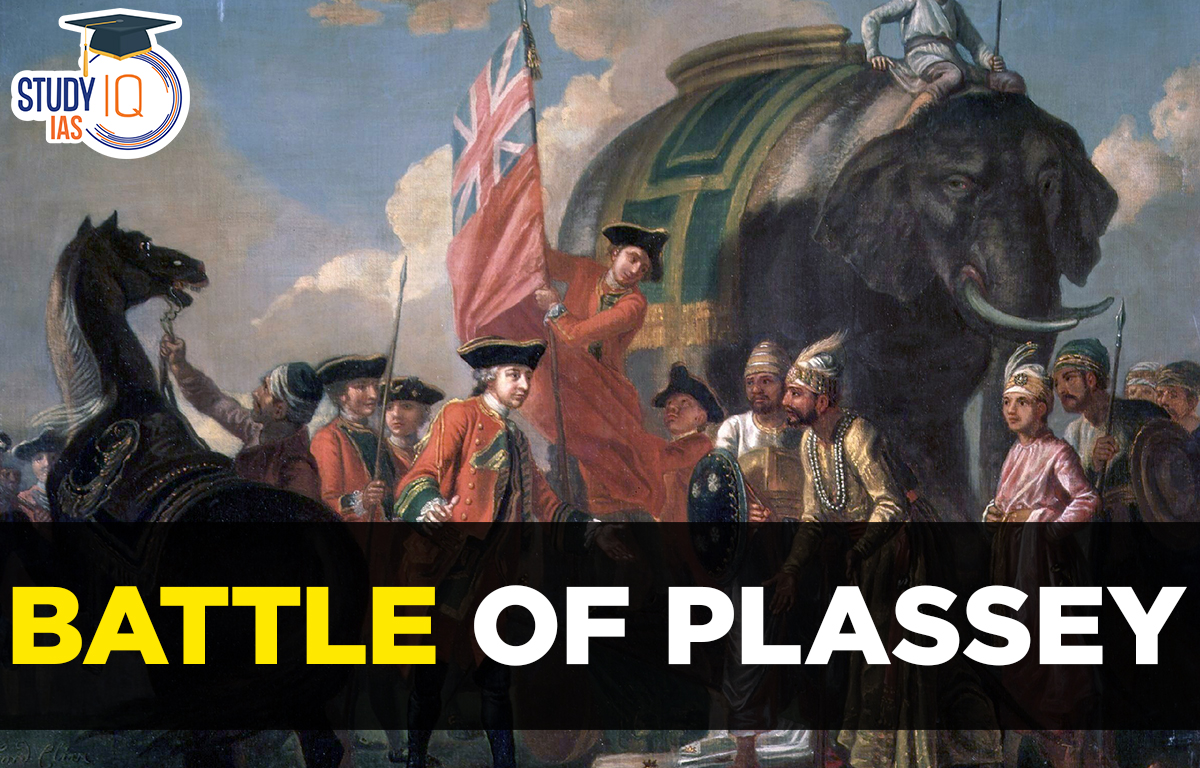Table of Contents
The Battle of Plassey, fought on June 23, 1757, was a significant event in Indian history that marked the beginning of British colonial rule in India. The battle occurred near the village of Plassey in Bengal, in present-day West Bengal, India. It was fought between the British East India Company, led by Robert Clive, and the forces of Siraj ud-Daulah, the Nawab of Bengal, Bihar, and Orissa. Here’s an overview of its history, causes, and impacts in this article.
Battle of Plassey
The Battle of Plassey took place on June 23, 1757, in the West Bengali region of Plassey. The Nawab of Bengal, Siraj-ud-daula, and the British East India Company, led by Robert Clive, engaged in this fight. In this conflict, the French soldiers fought alongside Siraj-ud-daula against Robert Clive. The Battle of Plassey is an important part of history for UPSC Preparation.
| Description | |
|---|---|
| Date | June 23, 1757 |
| Location | Near the village of Plassey in Bengal, present-day West Bengal, India |
| Parties Involved | British East India Company led by Robert Clive vs. Forces of Siraj ud-Daulah, the Nawab of Bengal, Bihar, and Orissa |
Battle of Plassey Background
- British East India Company’s Expansion: Company sought dominance in Indian trade, particularly in Bengal.
- Tensions with Nawab Siraj ud-Daulah: Siraj ud-Daulah, Nawab of Bengal, suspicious of British intentions due to their growing influence.
- Political Intrigues: British officials, led by Robert Clive, conspired with discontented local factions, promising support for their cause.
- Alliance with Mir Jafar: Mir Jafar, a key noble, agreed to support the British in exchange for becoming Nawab after the battle.
- Capture of Calcutta: Siraj ud-Daulah captured Calcutta in 1756, leading to the Black Hole incident.
- Clash at Plassey: June 23, 1757, saw a battle between British and Siraj ud-Daulah’s forces near Plassey.
Causes of Battle of Plassey
- Economic Interests: The British East India Company had established trading posts in India and was increasingly asserting its economic dominance. The Nawab of Bengal, Siraj ud-Daulah, perceived the Company’s growing influence as a threat to his own power and revenue.
- Political Intrigues: British officials conspired with local Indian nobles who were discontented with Siraj ud-Daulah’s rule. They promised support to these discontented factions in exchange for favorable treatment and trading privileges.
- Military Discontent: Siraj ud-Daulah had a large army but lacked effective leadership. His army was also not adequately equipped or trained, which weakened his position against the more organized and disciplined British forces.
Important Persons in Battle of Plassey
1. Siraj-ud-Daulah
The Nawab of Bengal was named Siraj-ud-Daulah. It is said that Siraj-ud-Daulah imprisoned 146 English people who were confined to a very small room, causing 123 of them to suffocate to death. While Calcutta was governed by the British, Siraj-ud-Daulah invaded and captured the English fort there.
2. Robert Clive
The East India Company’s top commander in Bengal was Robert Clive. Robert Clive granted sanctuary to Krishna Das, the economic fugitive son of Raj Vallabh, disappointing the Siraj-ud-Daulah. He abused the East India Company’s right to commerce. He strengthened the fort at Calcutta without the Nawab’s consent.
3. Mir Jafar
He was an excellent military leader for the Nawabs. He was bought by the East India Company to defraud Siraj-ud-Daulah. He planned with the East India Company in an effort to succeed as Bengal’s Nawab.
4. Rai Durlabh
He served as a representative in the nawab’s courts. Although he joined Siraj-ud-army, Daulah’s he did not participate in battle, betraying Siraj-ud-Daulah.
5. Jagat Seth
He worked in finance. Siraj-ud-Daulah was imprisoned and then killed as a result of his participation in the conspiracy.
6. Omi Chand
He was a commanding officer over Calcutta. He was in charge of signing the agreement that Clive and others negotiated prior to the Battle of Plassey.
Battle of Plassey Chronology
The Nawab stormed and took control of the firm’s plant in Kasim Bazar as a measure of warning after the company disobeyed his orders to prohibit the usage of Dastak and stop the building of Fort William. The company pillaged and ransacked Hooghly as retaliation. This further enraged the new Nawab, who invaded Fort William in June 1756.
The company’s officials were caught off guard and outnumbered; some of them surrendered and were taken prisoner; others managed to escape through the back gate and into the Hooghly River. Along with Governor Drakes, they sought refuge on the tidal island known as Fulta in the Hooghly River, and from Fulta, they despatched a letter to Madras.
The English Prisoners were imprisoned under Nawab’s decree. He changed Calcutta’s name to Alinagar, granted Manik Chand administrative control of the new city, and then left for Murshidabad. Meanwhile, a sizable British army led by Admiral Watson and Robert Clive arrived in Bengal from Madras in December 1756.
Nawab learned of this and, as a result of his dread of being attacked by Ahmed Shah Abdali and the Marathas, he decided to try to reach a settlement with the English. Manik Chand, meanwhile, had peacefully ceded Calcutta to the English. Robert Clive and Nawab Siraj-ud-Daulah began the negotiations that led to the Treaty of Alinagor, which was signed in February 1757.
According to this agreement, Clive pledged that the company would refrain from attacking the French at Chandra Nagar in exchange for the Nawab restoring the company’s trading privileges, allowing it to fortify Fort William, and paying it a war indemnity.
However, the company invaded Chandranagar in April 1757, and the French were routed. Nawab spoke with Clive, arrived in Calcutta with a little army, and then proceeded to Omichand’s property. Britisher believed that the Nawab was fighting and attacked him.
At Plassey in Nadia, West Bengal, both sides engaged in combat with one another. British troops were 3,000, and the Nawab had nearly 65,000 soldiers, but a plot hatched by Mir Jafar and Robert Clive resulted in the arrest and imprisonment of the Nawab Siraj ud-Daulah, and the subsequent murder of the Nawab by Mir Jafar’s son Miran.
Battle of Plassey Result
The result of the Battle of Plassey had profound and far-reaching consequences. Here is a summary of the key results:
- British Victory: The British East India Company, led by Robert Clive, decisively defeated the forces of Siraj ud-Daulah, the Nawab of Bengal.
- Installation of Mir Jafar: Mir Jafar, who had conspired with the British, was installed as the new Nawab of Bengal. He served as a puppet ruler under British control, allowing the Company to effectively control Bengal’s administration and resources.
- Political Control: The victory marked the beginning of British political dominance in India. The British East India Company expanded its influence and control over Bengal, setting a precedent for further annexations and consolidation of power.
- Economic Exploitation: The British gained control over Bengal’s vast wealth and resources, leading to significant economic exploitation. This facilitated the transfer of wealth from Bengal to Britain and contributed to the economic impoverishment of the region.
- Foundation of British Raj: The Battle of Plassey laid the foundation for nearly two centuries of British colonial rule in India. It was a critical step in the establishment of the British Raj, which formally began in 1858.
- Decline of Mughal Influence: The battle signaled the decline of Mughal influence in India, as regional powers like the Nawabs of Bengal were subdued by the British.
- Military and Administrative Reforms: The British victory led to significant military and administrative changes in the regions they controlled. The East India Company reorganized its army and administration to strengthen its grip on power.
- Resistance and Revolts: The British victory and subsequent policies fueled resentment and resistance among the Indian populace, leading to various uprisings and revolts against British rule, including the major revolt of 1857.
Battle of Plassey Significance
The Transfer of Power was a result of the Battle of Plassey, which is why it is significant. Mir Jafar rose to the position of Nawab of Bengal after the Battle of Plassey. Mir Jafar was a puppet of Nawab, the firm employed him merely to meet its financial requirements. Therefore, that business could swiftly push its colonial interests. The corporation was of an Imperial nature, thus Mir Jafar was unable to satisfy its rapacious demands.
Mir Jafar thus began to become less important in the company’s imperial game. In order to discredit him, it was said that he had conspired with Dutch, but the truth was that he had failed to pay the vast sum of money the corporation had requested.
A deal was reached between the British firm and Mir Kasim as a result, and in September 1760, control was transferred. Some historians viewed this change in power in Bengal as a precursor to a revolution.
Battle of Plassey UPSC
- The incident sparked the 1764 Battle of Buxar.
- Mir Jafar’s power was transferred to Mir Kasim, who took over as the new Nawab of Bengal.


 Desert Climate, Distribution, Climatic C...
Desert Climate, Distribution, Climatic C...
 Deserts of India Map, Features of Thar D...
Deserts of India Map, Features of Thar D...
 Maharashtra’s Mendrachi Vancharai Syst...
Maharashtra’s Mendrachi Vancharai Syst...





















